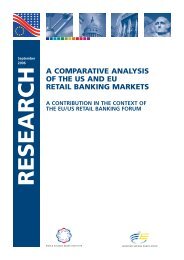Corporate Governance and Access to Finance - ESBG
Corporate Governance and Access to Finance - ESBG
Corporate Governance and Access to Finance - ESBG
Create successful ePaper yourself
Turn your PDF publications into a flip-book with our unique Google optimized e-Paper software.
nThe study also shows that <strong>Corporate</strong> <strong>Governance</strong> components whichare under the control of the institutions have more influence onpromoting better accessibility <strong>to</strong> financial services than the countrycomponents, connected <strong>to</strong> the national legal framework or thebusiness environment. In this respect, the “internal” elements of<strong>Corporate</strong> <strong>Governance</strong> that contribute most <strong>to</strong> a higher <strong>Access</strong> <strong>to</strong><strong>Finance</strong> are (i) the inclusion of a clear reference <strong>to</strong> <strong>Access</strong> <strong>to</strong> <strong>Finance</strong>in the mission statement of the institution; (ii) the separation betweenCEO <strong>and</strong> Chairperson; (iii) the existence of an external audit, aninternal <strong>Corporate</strong> <strong>Governance</strong> Code <strong>and</strong>/or a rating from an externalagency, <strong>and</strong> (iv) the proportion of women in the Board.<strong>Corporate</strong> <strong>Governance</strong> practices <strong>to</strong> improve <strong>Access</strong> <strong>to</strong> <strong>Finance</strong>nnnThe members of the WSBI are diverse, including public banks,cooperatives, mutuals, postal savings institutions, private institutionsetc. Each of these types of institutions has certain specificities fromthe point of view of <strong>Corporate</strong> <strong>Governance</strong>, given their specificorganizational <strong>and</strong> ownership structure (see section 3). Despite thesedifferences, they share a number of common <strong>Corporate</strong> <strong>Governance</strong>characteristics.This similarity is partly the result of the fact that most WSBI memberscomply with st<strong>and</strong>ard Codes of <strong>Corporate</strong> <strong>Governance</strong>, although thelatter are in general designed for shareholder-driven institutions.Overall compliance with such codes <strong>and</strong> st<strong>and</strong>ards, in accordance withBasel Committee recommendations, is beneficial for any financialinstitution. It is however advisable <strong>to</strong> tailor these codes <strong>to</strong> the specificcharacteristics <strong>and</strong> mission of WSBI members, which share a “doublebot<strong>to</strong>m line” objective. It is desirable that <strong>Corporate</strong> <strong>Governance</strong>mechanisms in these institutions reflect a balance between the twoobjectives of <strong>Access</strong> <strong>to</strong> <strong>Finance</strong> <strong>and</strong> sustainability.For institutions having a strong financial inclusion aim, it is important<strong>to</strong> include an explicit reference <strong>to</strong> this objective in the mechanismsthat ensure accountability of the governing bodies. Clarity of the<strong>Access</strong> <strong>to</strong> <strong>Finance</strong> mission is indeed essential <strong>to</strong> ensure that businessstrategic policies <strong>and</strong> operations are directed <strong>to</strong>wards this goal.15
















